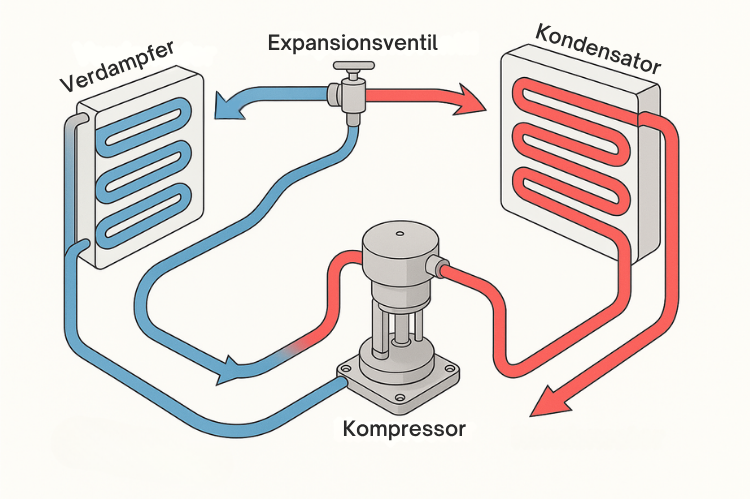Invisible but crucial: refrigerants in everyday life
Refrigerants are key components of modern air conditioning and heating systems. Whether in the heat pump, the air conditioning system in the office or the refrigerator at home - without them, no heat transport would be possible. But although they usually remain invisible, they play a crucial role in energy efficiency, safety and the quality of the air we breathe.
What are refrigerants such as R32, R454B and R454C?
Refrigerants are chemical substances that absorb, transport and release heat. This makes them the basis for all appliances that cool or heat.
Typical areas of application in everyday life:
- Air conditioning systems: Refrigerants ensure that rooms or vehicle cabins are cooled to comfortable temperatures (for example at home, in the car or office)
- Heat pumps: They extract heat from the environment to heat buildings. Here too, the refrigerant transports the energy between the indoor and outdoor units.
- Refrigerators and freezers: Refrigerants ensure that food can be constantly cooled.
- Industrial plants: Large cooling circuits, data centers or production plants use special refrigerants for process cooling.
How they work:
The refrigerants circulate in a closed circuit consisting of an evaporator, compressor, condenser and expansion valve.
In the evaporator, the refrigerant absorbs the heat from the environment and evaporates in the process. The compressor then compresses the gas, causing its temperature to rise. In the condenser, the refrigerant releases the absorbed heat again and liquefies before the cycle starts again.
This cycle is repeated continuously and enables cooling or heating. Without refrigerant, such appliances would simply not be able to function.

Modern refrigerants: R32, R454B and R454C
As older refrigerants such as R134a, R410A (so-called HFCs, i.e. fluorinated greenhouse gases with a high global warming potential) or R22 have a very high global warming potential, refrigeration and heating technology is increasingly relying on new, more environmentally friendly refrigerants such as R32, R454B and R454C. These so-called A2L refrigerants have an impressively low global warming potential (GWP), but are also highly flammable. This means that reliable gas monitoring is becoming increasingly important.
R32 (difluoromethane, CH2F2)
- Application: Air conditioning systems and heat pumps
- Advantages: low GWP (Global Warming Potential), high energy efficiency
- Special feature: highly flammable (requires safety measures)
R454B (68.9% CH2F2; 31.1% C3H2F4)
- Application: Replacement for older HFC mixtures such as R410A
- Advantages: significantly lower GWP, similar efficiency to predecessor
- Special feature: highly flammable (requires safety measures)
R454C (78.5% CH2F2; 21.5% C3H2F4)
- Application: Air conditioners and heat pumps, especially in industry
- Advantages: low GWP, energy-efficient
- Special feature: also highly flammable
What happens when refrigerants are released into the air?
As long as the system is sealed, the refrigerant remains in the closed circuit. However, if there is a leak, it escapes into the environment, usually in gaseous form. This, and the fact that refrigerants are usually colorless and odorless, makes a leak difficult to detect. Even small leaks can lead to considerable emissions over a long period of time.
Health risks:
- Irritation of the respiratory tract
- Headache, dizziness or drowsiness (due to oxygen displacement)
- in very high doses, influence on the central nervous system
- Cold burns on contact with liquid refrigerant
- A flammable gas-air mixture may occur in closed rooms.
Environmental impact:
Many refrigerants contribute significantly to the greenhouse effect, especially HFCs such as R410A or R134a. They have a global warming potential up to 2,000 times higher than CO₂.
Older substances such as R22 also damage the ozone layer and are therefore now banned or strictly regulated.
Newer alternatives such as R32, R454B or natural refrigerants (propane, isobutane, CO₂) are significantly more climate-friendly, but require higher safety standards.
Leaks in cooling circuits therefore not only lead to performance losses and expensive repairs, but also to avoidable emissions that pollute the climate and the environment.
Detect refrigerants: Safely monitor R32, R454B & R454C with air-Q
The new air-Q sensors can directly detect and offer R32, R454B and R454C:
- Early leakage detection
- Real-time alarm via app, dashboard or API
- Visualization and data recording
This ensures that modern refrigerants are used efficiently and without risk.
Refrigerants are indispensable for the operation of modern air conditioning technology, but their properties also make them sensitive substances. Leaking gases can be harmful to both health and the environment.
The air-Q helps to detect such changes in the air at an early stage. With the new sensor options, the system upgraded its range of applications and contributes to the safe operation of modern, environmentally friendly refrigeration technology. Air quality, safety and system efficiency can thus be kept in view at all times.













